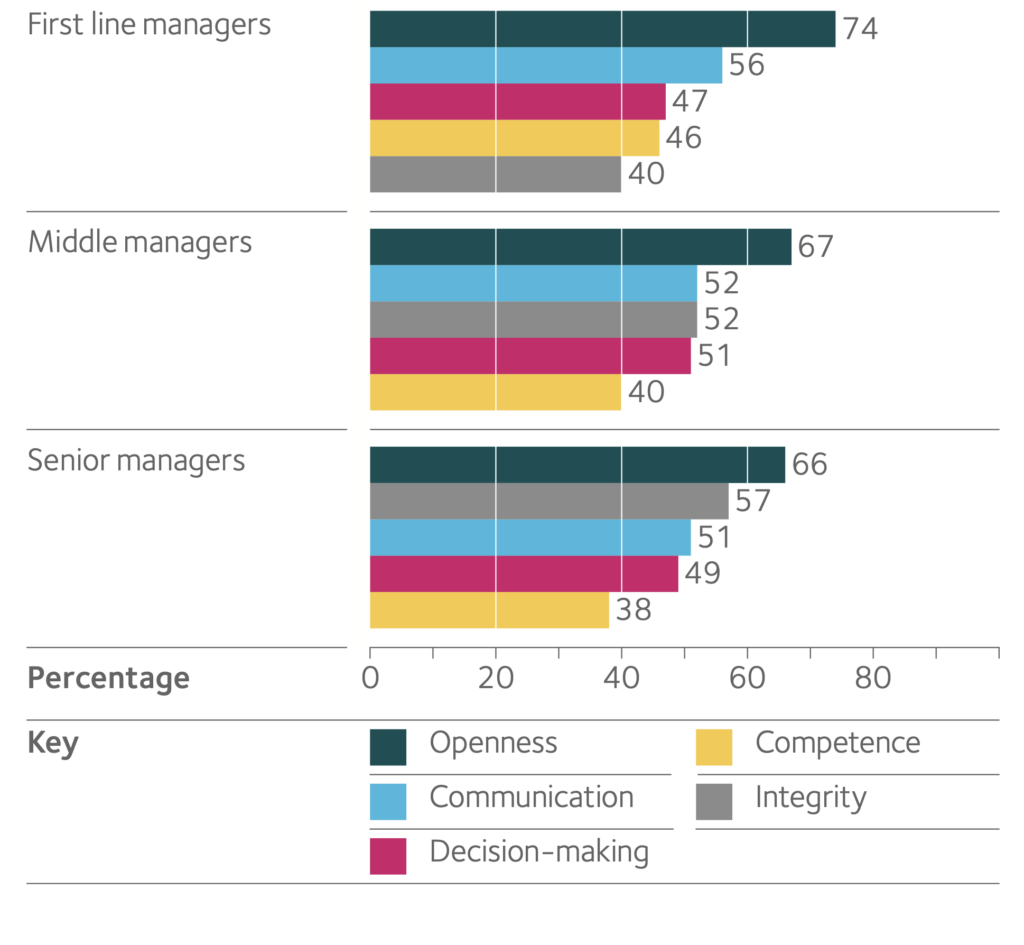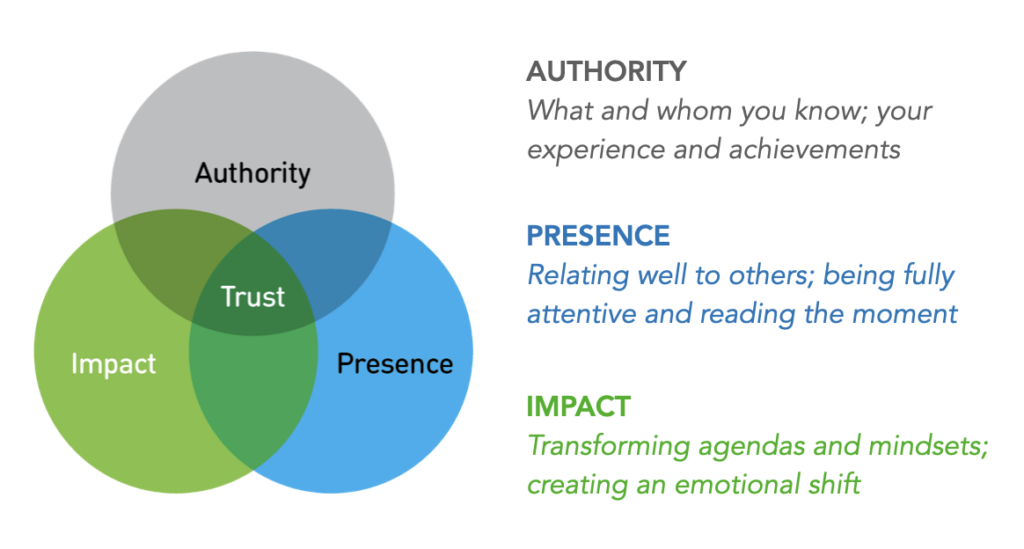Believability goes way beyond authenticity; it is a sustained balance of influence, authority, credibility, trust and reputation. And it is rapidly becoming the key conversation with business leaders who are increasingly finding it tough to engage effectively with their people and their clients.
So let’s break this down a little. What do we mean by believability?
Leadership believability is the degree of alignment between a leader’s beliefs, behaviours and judgments and whether they are consistently worthy of the trust from those around them. Put more simply, “do I understand your intention and trust that you will follow it with action?”
“Truth is terrific, reality is even better, but believability is the best of all.”
William Goldman (novelist and playwright) 1931 – 2018)
The challenge for the leader in this “belief contract” is that the key decision-maker is not the leader themself; it is all about the follower.
And followers are more cynical and disengaged than ever before; many feel let down by the calibre of leadership they see around them. The behaviours of populist politicians, a brazen post-truth culture, catastrophic business failures and disturbing deep fake technology have all contributed to an unsettling, wider context of mistrust.

Here in the UK, our faith in politicians is diminishing rapidly – back in 1944, just 35% of those asked saw politicians, of all parties, as “out for themselves”. By 2014 that had risen to 48% and by 2021 a shocking 63% of those asked said they share the view that our politicians put themselves before others.
And this sentiment is bleeding into our day to day: business leaders (perhaps unfairly) are branded as being out of touch, self-serving, and focussed on profit before all else. Recent Gallup research suggests that only 1 in 5 employees in the US have strong trust in their senior leaders and in the UK, a full 9% of first line managers trust “few people or absolutely no one at work”.
Whichever way you look at it, these two pieces of research highlight a worrying trend.
“Only 21% of U.S. employees strongly agree that they trust the leadership of their organisation.”
Why Trust in Leaders Is Faltering and How to Gain It Back – Gallup
Denise McLain and Ryan Pendell
These statistics alone should be a rallying cry for early and sustained leadership development in our organisations and institutions. In our work we see the Leadership Loopholes that are quietly draining businesses of potential value and we are dedicated to helping them restore faith in a culture of modern leadership. So now it is time for leaders, wherever they are in our organisations, to up their game and focus on winning back the hearts and minds of the people around them.
And the way back into this relationship is by prioritising “believability”.
So what matters most to employees?
According to the Institute of Leadership & Management, 70% of managers rank “openness” as a top driver of trust, followed by “communication”, “decision-making”, “integrity” and “competence”.
And whilst the individual percentages vary by seniority, it seems clear that what we respect are leaders who are prepared to enter into mature conversations with us and face into challenging conversations.

As we might also expect, the challenge of believability gets harder the bigger the organisation gets. We crave intimacy and find it easier to build connection and empathy when we have more frequent contact, so leaders in larger organisations (and we are talking 1000+ employees here) need to work even harder on this agenda.

The components of believability
For me, believability is more than trust; it goes even deeper. It is a complex combination of emotional and rational components that need to be demonstrated consistently and frequently. It is a tightrope of reputation-building; one false step and all that carefully constructed credibility falls from the high wire, with no safety net.

I tend to see believability in these terms:
TRUST + VULNERABILITY
AUTHENTICITY + REPUTATION
LIKABILITY + PASSION
GOODWILL + PURPOSE
RAPPORT + INTEGRITY
It is much more than any single behaviour or value, it is more the sense of combination, a determination to be authentic over time, to show care and be likeable, to be passionate and engaging.
Of course, a great starting point for any conversation about believability is trust and you could certainly do worse than look at The Speed of Trust by Stephen Covey or The Trusted Advisor by Maister, Green and Galford. In the latter, the central argument of their Trust Equation is that trust is the result of four determinants: the degree to which we are perceived to be credible, reliable and intimate (emotionally connected), enhanced by low self-orientation in service of the client.
We refer to the Trust Equation a lot when helping leaders think about their close relationships with team members and stakeholders. It makes sense and is easy to talk through.

But it is predicated on the idea of how consultants can build trust with clients so it doesn’t really get us to the wider sense of leadership reputation and believability.
Equally, you could look at the Authority, Presence, Impact model of trust developed by Professor Peter Hawkins, but that focuses on building trust from the performance stage, from the storyteller’s perspective. Again, a great model for helping leaders consider how gravitas and rapport build reputation but we need to get deeper if we are going to get to believability.

What gets us to believability seems to be when a leader is prepared to be vulnerable; to be open and disclosing; to acknowledge who they are, both for their strengths and weaknesses. And perhaps it is this that makes it so challenging for many to do?
This is the Vulnerability Paradox.
“[Vulnerability is] the first thing I look for in you and the last thing I want you to see in me.”
Brené Brown, researcher and author
And yet, as the researcher and writer, Brené Brown suggests, “vulnerability is the birthplace of courage, innovation, creation, and change; it connects us with our sense of worthiness and our sense of belonging.” But it runs so contrary to our long held, conventional ideas about leadership, which emphasise strength, decisiveness and control, that for many it is just a step too far. We prefer to stay behind the wall, to protect ourselves, to not run the potential risk of judgement and uncertainty. But in so doing, we lose one of the most significant clues to believability.
The challenge for leaders when building believability
Leaders face an uphill struggle when it comes to believability, and it isn’t entirely their own fault. Believability is in the hands of the follower and it is this perception of credibility or trustworthiness that matters, as much as the actuality. It is the subjective judgment that individuals make based on their own value filters and cognitive processes, their previous, perhaps poor, experiences of leadership, and the wider context of media reporting, canteen chatter and work culture.
The playing field isn’t flat, it is skewed in favour of cynicism and outraged storytelling. We love a dramatic negative story, a leader’s fall from grace, a confirmation of hypocrisy and double standards.
So what are the fundamental hurdles for leaders seeking to build their believability?
- Confirmation Bias: People tend to more readily believe information that aligns with their pre-existing beliefs and reject contradictory information. If I believe that all politicians are corrupt, it reassures me that I am correct when I hear news stories that confirm my narrative and this can be incredibly stubborn to shift.
- Being misunderstood: It is easy to assume that others understand our intentions; but what others actually experience are our actions and the outcomes. There is often a big difference between our intention and our impact. If we don’t share our thinking process and spend time explaining our rationale, we run a very high risk being misunderstood.
- Distortion: Leadership messages are not always delivered and clarified directly; they are broadcast, relayed and filtered through layers of hierarchy. At each stage those messages are vulnerable to a degree of distortion. They will be explained and understood differently based on local context and culture.
- Distance: We have already seen how trust diminishes with scale; the larger your organisation, the harder it is to build intimacy and connection without consistent and determined effort. Equally, hierarchy reinforces psychological distance and the steeper the status curve, the tougher it is going to be to establish long term believability.

What helps leaders be more believable?
When Management Review surveyed more than 7,500 managers from private and public organisations to understand what they really wanted from their leaders, the sentiments were pretty consistent:
- Honesty and integrity
- Competency in role
- Inspiration
- Sense of direction and concern for the future of the company.
What these respondents are clearly telling their leaders is that they want them to be credible; they want to feel acknowledged and significant, they want leaders who stand up for their beliefs and principles, and who share their ideas with passion. They want to see clear role modelling of effective leadership and confident humility.
8 ways to enhance your leadership believability
Finally, if you want to be more believable as a leader then it starts with a fundamental and rigorous assessment of what your leadership stands for and what you want your story to be. This is a long term, reputation-building exercise based on a rock solid foundation of authenticity, personal values and direction.
Here are the eight leadership characteristics to start with:
Clarity of Purpose
Have a crystal clear sense of what you are seeking to achieve as a leader. Work hard to distill this down to an easily understood “signature” that doesn’t get distorted in translation and doesn’t need explanation by others. Be prepared for disagreement and challenge; expect it; be concerned if you don’t get it – your clarity of purpose is a call to action, a challenge to the status quo and must be worth striving for.
Leadership Competency
Leadership is a craft that takes dedication and hard work and it is this determination to be better, to learn and be vulnerable that builds credibility. Nobody is perfect and it is fine to get things wrong occasionally, as long as we face into the situation and have the humility to acknowledge the learning. But we do want leaders to put in the hard miles, to strive for excellence and deliver on their leadership promise.
Passionate Leadership
We are drawn to leaders that we can connect with emotionally, who care about us, who share their excitement with us and who can describe a compelling vision for the future. We need to see ourselves in their journey and understand the contribution we can make. This permission to care, to be enthusiastic and to inspire others to greatness is an emerging leadership competency; one that we cover in more detail here.
Integrity
Defined as “the quality of being honest and showing a consistent and uncompromising adherence to strong moral and ethical principles and values”, integrity is often tested and easily compromised. Lying, and being caught out in that lie, or withholding important information from those around you, destroys believability. Aim for openness and candour at all times, face into difficult decisions and when you can’t disclose everything, say so; be as transparent as possible, sharing not just “what” but “why”.
Reliability
An element of consistency and reliability can be an incredibly reassuring leadership trait. In a frenetic world of work, having leaders who exude calm professionalism, who show up and deliver is an antidote to the “amygdala hijack” we experience when we feel out of control and vulnerable. Sometimes dismissed in leadership circles as being too boring to talk about, don’t underestimate how reliability extends believability over time.
Connection
Believability is a fundamental sense of relatedness; that in some way we have a common understanding or bond; we “speak the same language” and are “on the same page”. Connection is about noticing others, making them feel valued and significant, about finding common ground and shared understanding. Of course, this connection is relatively easy to achieve with a team or small business but harder to do at scale. Use personal stories, easy metaphors and relatable anecdotes, rooted in the interests of your audience, to build connection.
Respect for Others
Believability is a positive mindset; rooted in a deep and authentic sense of respect for others. We don’t have to agree on everything but we will listen to each other and challenge constructively. Leaders who are curious and show concern and interest in the perspectives of others tend to learn more and build leadership capital for the future. They destroy value by criticising others and engaging in office politics.
Leadership Accountability
We have seen too many examples of leaders who refuse to take responsibility for their actions; we have come to expect it. How refreshing is it to be with a leader who takes accountability for their actions and acknowledges the failings as well as the successes? A believable leader is a shield, protecting the more vulnerable and not allowing them to become scapegoats for leadership decisions taken elsewhere. They take ownership of the situation and seek to make amends in whatever way they can.
When you want to find out more about the work we are doing all over the world, developing believable leaders and high performance teams, please do get in touch.
We are ready when you are.



